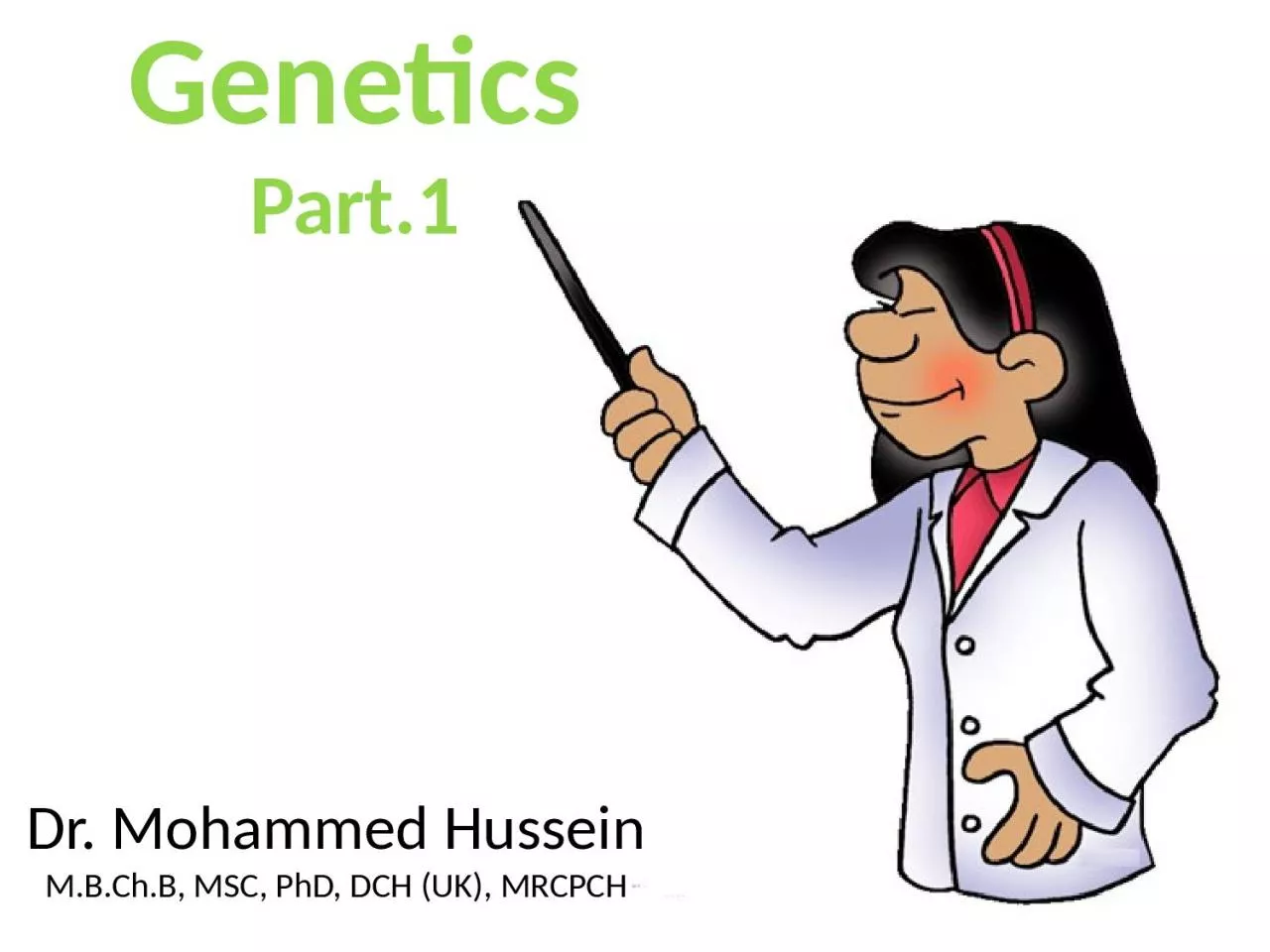

MBChB MSC PhD DCH UK MRCPCH Part 1 SingleGene Disorders Part 2 Population Genetics Part 3 Cytogenetics Genetics SingleGene Disorders Basic Definitions 46 Chromosomes 22 pairs ID: 920870
Download Presentation The PPT/PDF document "Genetics Part.1 Dr. Mohammed Hussein" is the property of its rightful owner. Permission is granted to download and print the materials on this web site for personal, non-commercial use only, and to display it on your personal computer provided you do not modify the materials and that you retain all copyright notices contained in the materials. By downloading content from our website, you accept the terms of this agreement.
Slide1
Genetics
Part.1
Dr. Mohammed Hussein
M.B.Ch.B, MSC, PhD, DCH (UK), MRCPCH
Slide2Part 1: Single-Gene DisordersPart 2: Population Genetics Part 3: Cytogenetics
Genetics
Slide3Single-Gene
Disorders
Slide4Basic Definitions
Slide546 Chromosomes
22 pairs
of autosomes
(autosomal chromosomes)
1 pair
of
Sex chromosome
Slide6The
two chromosomes in each diploid pair are said to be homologs, or homologous chromosomes.
X and Y chromosomes
,
have
some homologous regions but the majority of genes are different.
Slide7No. of chromosomesGametes (
ova and sperms) are haploid, have one copy of each type of chromosome (1–22, X or Y).Somatic cells (cells other than gametes) are diploid, having two copies of each type of autosome (1–22) and either XX or XY
Slide8Gene. Physically a gene consists of a sequence of DNA that encodes a specific protein.
Locus. The physical location of a gene on a chromosome is termed a locus. Alleles. Variation (mutation) in the DNA sequence of a gene produces a new allele at that locus. Many genes have multiple alleles.Polymorphism. When a specific site on a chromosome has multiple alleles in the population, it is said to be polymorphic (many forms).
Slide9Locus for eye color gene
Allele for blue eye color
Allele for brown eye color
Homologus
pair of chromosomes
Slide10Homozygous if the individual has the same allele on both homologous chromosomes at that locus.
Heterozygous if the individual has different alleles on the two homologous chromosomes at that locus.Hemizygous if the individual has one allele on one of the two homologs. Homozygous vs.
Heterozygous alleles
Slide11Slide12Slide13Slide14Genotype vs. Phenotype
The genotype is the specific DNA sequence at a locusThe phenotype is generally understood as the expression of the genotype in terms of observable characteristics
Slide15Slide16Mutations
Slide17The Recurrence Risk The recurrence risk is the probability that the offspring of a couple will express a genetic
disease.
Slide18Pedigrees (Family Tree)A patient’s family history is diagrammed in a
pedigree.
Slide19Slide20Slide21Slide22Child 2 in
Generation IV
IV-2
IV
III
II
I
1
2
43124312431
2
5
6
5
Slide23Child 11 in
Generation III
III-11
Slide24Mendelian
Inheritance
Slide25Slide26Autosomal Dominant InheritanceAutosomal Recessive
InheritanceSex - linked Dominant InheritanceSex - linked Recessive Inheritance
Slide27Autosomal Dominant InheritanceThis is the
most common mode of Mendelian inheritance.Caused by alterations in only one copy of a gene pair. This mean the condition occurs in the heterozygous state despite the presence of an intact copy of the relevant gene. AD genes are located on the autosomal chromosomes,
so
males and females are equally affected.
Slide28Suppose that A is a dominant allele that cause a disease
And a is a recessive allele that is normalHomozygous AA , aaHeterozygous Aa AA and Aa has diseaseaa
is normal
Slide29A a
a a
Normal
Diseased
Slide30A a
a a a
a
A
a
A
a A a a a a a50 % Disease50 % Normal
Normal
Diseased (Hetrozygous)
Punnett
Square
Slide31A a
A a a
A
A
a
A
A A a A a a a75 % Disease25 % Normal
Diseased (
Hetrozygous
)
Diseased
(
Hetrozygous
)
Slide32A A
a a a
a
A
A
A
a A a A a A a100 % DiseaseDiseased (Homozygous)Normal
Slide33Achondroplasia (Dwarfism)
Slide34Autosomal Dominant Pedigree
A
A
A
a
a
a
a
a
a
aA AA a
Slide35Familial hypercholesterolemia
Huntington diseaseNeurofibromatosis type IMarfan syndromeAchondroplasiaSpherocytosis
Slide36Neurofibromatosis type I
Slide37Autosomal Recessive
Inheritance
AR
alleles are clinically expressed only in the
homozygous
state.
The
offspring
must inherit one copy
of the disease causing allele from each parent.
Slide38Suppose that a is the disease allele and it is recessive.So the normal allele is the dominant (A
)Homozygous AA , aaHeterozygous Aa AA no diseaseaa has the diseaseAa has no disease (but he/she is a carrier for the abnormal gene),
Heterozygous carrier
Slide39A a
A a a
A
A
a
A
A A a A a a a75 % No Disease25 % Disease
50 %
Heterozygous Carrier
Heterozygous
carrier
Heterozygous
carrier
Slide40A a
A A A
A
A
a
A
A A A A a A a50 % Normal50 % Carrier
Heterozygous carrier
Homozygous normal
Slide41a
aaa
A
A
Slide42Carrier Risk
This person wants to know his carrier risk
Slide43Carrier risk for the individual
IV-1 is:25%33%50%67%75%
IV-1
IV
III
II
I
Hetrozygous
carrier
2/3 = 66.67% = 67%
Homozygous1/3 = 33.33% = 33%
Slide44Sickle cell anemia
Cystic fibrosisPhenylketonuria (PKU)Tay-Sachs disease
Slide45Phenylketonuria (PKU)
Slide46